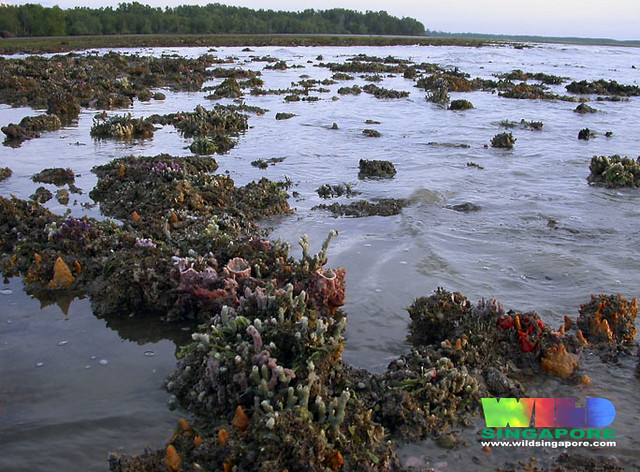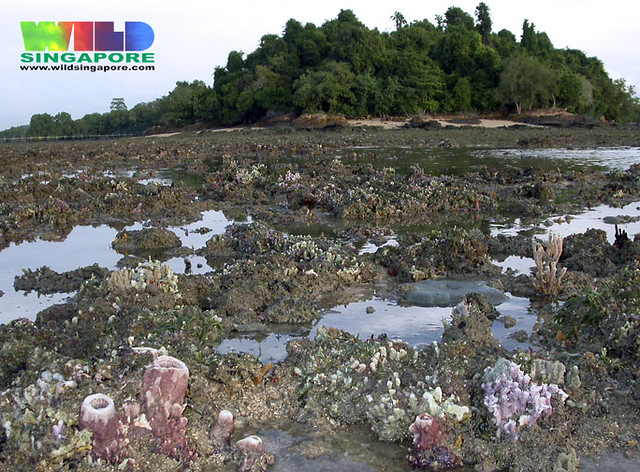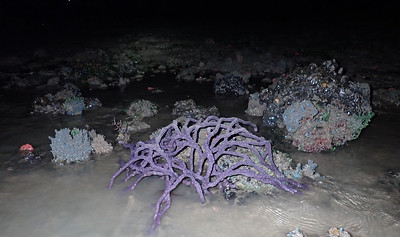Chek Jawa is looking more like it used to before the devastating mass deaths in 2007 which wiped out the sponges and many other animals here. Chek Jawa was also hit by the 300-tonne oil spill in the East Johor Strait in Jan 2017. So it was a relief to see such a magnificent array of marine life there this morning.
I was glad to see many sponges of various kinds all along the survey route from the House No. 1 Jetty to the Chek Jawa Front Beacon! I first noticed improved sponge diversity during our survey in Jul 2016, which improved further during our Jun 2017 survey and in our Jul 2018 survey.
As on our Jul 2019 survey, the edge near the beacon was a Spiky flowery soft coral garden! With many small colonies in pretty pastel colours. But today, I didn't any Pink flowery soft corals or Ball flowery soft corals.
I was glad to see many sponges of various kinds all along the survey route from the House No. 1 Jetty to the Chek Jawa Front Beacon! I first noticed improved sponge diversity during our survey in Jul 2016, which improved further during our Jun 2017, Jul 2018 and Jul 2019 surveys. The tide wasn't low enough for us to properly survey for sponges in 2020 (The Circuit Breaker 'ate up' the best low tides). Today, the area looks more and more like what I used to see nearly 20 years ago! Here's what I saw today.
With a variety of common sponges and other colourful encrusting animals growing on the coral rubble.
For the first time in a long while, it was great to see well developed clusters of Barrel sponges.
Although the sponge situation seems the best I've seen so far since the Big Flood of 2007. I feel it's not quite reached what I saw in the past.
 |
| Chek Jawa July 2002 |
 |
| Chek Jawa July 2002 (before the boardwalk was built) |
Today I saw a wide variety of sea fans. These include common ones like Candelabra sea fans, Gnarled sea fans, Skinny sea fans. But also less commonly seen ones like two Asparagus sea fan, a Flat-branch sea fan, a Maze sea fan and a white Sea whip. Nevertheless, there were far more sea fans seen on recent surveys at Changi. Also, while the sea fans at Changi had lots of Spindle cowries on them, I couldn't find any on the sea fans at Chek Jawa today.
With the alert to possible mass coral bleaching in early June, and sightings of some sick corals at Kusu Island yesterday, we checked on the corals at Chek Jawa too. I saw about 20 small to medium sized Boulder pore corals. Most were a nice and healthy brown. A few were pale or had dead portions. I saw 3 that were bleaching.
I also saw 3 small colonied of Boulder sandpaper coral, 2 were bleaching - one of which had dead portions, while one was alright. I also saw 3 medium sized Flowery disk corals, all healthy. As usual, there were small patches of Zebra coral.
I'm not really good at finding creatures, the rest of the team are better at it. I did see many octopuses, and many Pygmy squids as well as some small Bigfin reef squids. I saw the usual variety of cowries for this location: Onyx cowries, Miliaris cowrie and other more common cowries. And some common flatworms. I also saw a few Hairy sea hares in the seagrass areas.There were also a lot of synaptid sea cucumbers, both the small ones and larger ones. I saw two Black long sea cucumbers - which are usually only common on our southern shores.Similar to what I saw on our last surveys here in Aug 2020, seagrasses have 'taken over' parts of the coral rubble area that used to be rather bare. There were dense growths of Spoon seagrass (big and small leaf blades) and dense growths of Needle seagrass (narrow and broad leaves). It was good to see lots of Fern seagrass as well. I saw three clumps Tape seagrass growing on the outer edge of the rubbly area, with longish leaf blades. Smooth ribbon seagrasses are doing very well growing in a large portion of the area between the beacon and the boardwalk. Looking closer at a small stretch of seagrass, I saw a good variety sea stars and sea cucumbers, as well White sea urchins. Although I didn't across any dugong feeding trails, we also did not come across any fresh nets or traps along our survey route. Hurray!Thanks to NParks for permission and support to do these predawn low spring tide surveys of Chek Jawa. Thanks also to Chay Hoon for making all the transport arrangements. And the team for helping to cover as much ground as we can during the narrow low tide window. Thank you!
What is the fate of Chek Jawa?
Chek Jawa and Pulau Sekudu may be affected by the 2030 landuse plan by the Ministry of National Development. The plan includes plans for a road link (black line) from the mainland jumping off at Punggol, crossing to Pulau Ubin through Chek Jawa to jump off to Pulau Tekong before circling back to the mainland on Changi East. Proposed reclamation (in yellow) will bury Pasir Ris shores, Pulau Sekudu and Chek Jawa as well as a large amount of shore at Changi Beach. I feel it is thus important to update our understanding of what is going on in the field at these sites including Chek Jawa and Pulau Sekudu.
 |
| click on images for larger view. |
The Singapore Blue Plan 2018
Among the Proposed Areas for Immediate Conservation Priority, the Singapore Blue Plan 2018 proposes that the intertidal and subtidal marine areas of Pulau Ubin to be designated Marine Reserve.
The proposed area would include Tanjung Chek Jawa, the largest known intertidal area in northern Singapore. Considered one of the richest in Singapore, Chek Jawa comprises many adjacent ecosystems: coastal hill forest, mangrove areas, rocky shores, seagrass meadows, coral communities, and sandy areas. Chek Jawa remains an icon of celebration and hope for many Singaporeans since its reprieve from reclamation in 2001.
 |
| The Chek Jawa boardwalk allows easy experience of the ecosystems there! More here. |
Much of the remaining coastal areas around Pulau Ubin are mangrove areas. Protecting these can be impactful due to the relatively large interconnected areas. Already, a community-driven project, Restore Ubin Mangroves (R.U.M.) Initiative, is in place to rehabilitate mangrove areas previously converted to fish and shrimp farms. These areas also offer hope for the recovery of the smallclawed otter population.
DOWNLOAD the Plan, SUPPORT the Plan! More on the Singapore Blue Plan 2018 site.
Photos by others on this survey
Chay Hoon
Loh Kok Sheng
Vincent Choo
Richard Kuah













